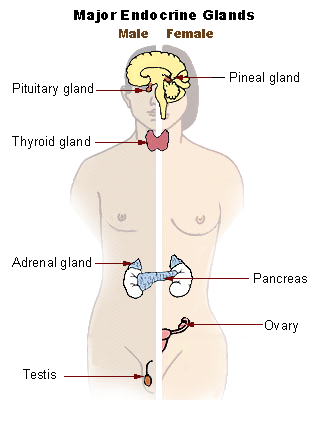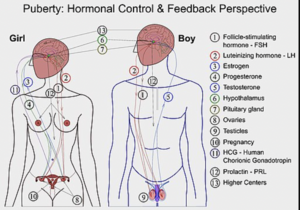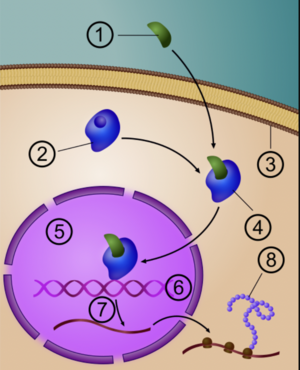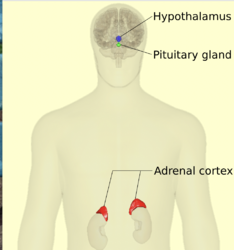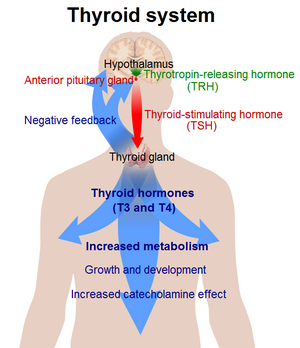Hormones
Original Editor - Lucinda hampton
Top Contributors - Lucinda hampton and Kim Jackson
Introduction[edit | edit source]
Hormones are molecules that are produced by endocrine glands, eg the hypothalamus, pituitary gland, adrenal glands, gonads, (i.e., testes and ovaries), thyroid gland, parathyroid glands, and pancreas. The endocrine glands respond to specific stimuli and the the products of these glands are released into the bloodstream. The hormones then are carried via the blood to their target cells.
Some hormones have only a few specific target cells, others affect numerous cell types throughout the body. The target cells for each hormone are characterized by the presence of certain docking molecules (i.e., receptors) for the hormone that are located either on the cell surface or inside the cell. The interaction between the hormone and its receptor triggers a cascade of biochemical reactions in the target cell that eventually modify the cell’s function or activity[1].
The Endocrine System[edit | edit source]
The Endocrine System is a collection of glands and organs that produce and regulate hormones in the bloodstream to control many functions of the body. This system overlaps with the nervous system and exocrine system, and its responsibilities include metabolism, growth and sexual development. Most animals that have advanced physiology, such as vertebrates and crustaceans, have an endocrine system.[2]
Mechanism of Action[edit | edit source]
Several classes of hormones exist. Those hormone classes differ in their general molecular structures (e.g., size and chemical properties). As a result of the structural differences, their mechanisms of action (e.g., whether they can enter their target cells and how they modulate the activity of those cells) also differ.
- Steroids: produced by the gonads and part of the adrenal cortex. Lipid-soluble and can diffuse easily into the cell membrane of the target cell. The molecules interact with receptors in the cytoplasm or in the cell nucleus. The hormone-receptor complexes then bind to certain regions of the cell’s genetic material (i.e., the DNA), thereby regulating the activity of specific hormone-responsive genes.
- Amino acid derivatives: modified versions of some of the building blocks of proteins. The thyroid gland and the adrenal medulla) produce this type of hormone. Like steroids, amino acid derivatives can enter the cell, where they interact with receptor proteins that are already associated with specific DNA regions. The interaction modifies the activity of the affected genes.
- Polypeptide and protein hormones: chains of amino acids of various lengths (from three to several hundred amino acids). These hormones are found primarily in the hypothalamus, pituitary gland, and pancreas. They are water-soluble and connects with receptors at the membrane, as they can’t diffuse through the membrane. As peptide hormones bind to receptors at the surface, their effect is faster than steroid hormones.[1][3].
Regulation of Hormone Activity[edit | edit source]
To maintain the body’s homeostasis and respond appropriately to changes in the environment, hormone production and secretion must be tightly controlled.
- The levels of some of the hormones are regulated in a fairly straightforward manner by the end products that they influence. Thus, blood sugar levels primarily regulate insulin and glucagon release by the pancreas.
- Other hormones (e.g.Hypothalamic-Pituitary-Adrenal (HPA) Axis) are parts of hormone cascades whose activities are controlled through elaborate feedback mechanisms. In addition, numerous indirect interactions exist between the various hormone systems governing body functioning.
Types of Hormonal Problems[edit | edit source]
Any small alteration to your hormones can lead to problems, including:
- Hyperthyroidism
- Hypothyroidism
- Estrogen imbalance: women sometimes suffer from an imbalance or increase in estrogen levels.
- Polycystic ovary syndrome (PCOS).
- Testosterone imbalance: Deficiency or excess.
- Hypogonadism.
- Cushing's Syndrome
- When a person perceives a situation to be challenging, threatening or uncontrollable, the brain initiates a cascade of events involving the hypothalamic-pituitary-adrenal (HPA) axis, which is the primary driver of the endocrine stress response. This ultimately results in an increase in the production of steroid hormones called glucocorticoids, which include cortisol ( a stress hormone). Chronic stress can result in impaired communication between the immune system and the HPA axis which are linked with chronic fatigue, metabolic disorders (e.g., diabetes, obesity), depression and immune disorders.
Further Reading[edit | edit source]
See Endocrine System
References[edit | edit source]
- ↑ 1.0 1.1 Hiller-Sturmhöfel S, Bartke A. The endocrine system: an overview. Alcohol health and research world. 1998;22(3):153. Available:https://www.ncbi.nlm.nih.gov/pmc/articles/PMC6761896/ (accessed 16.5.2022)
- ↑ Wise geek What is the endocrine system Available from:https://www.wisegeek.com/what-is-the-endocrine-system.htm (accessed 24.12.2020)
- ↑ Bodytomy Steroid vs Peptide hormone Available from:https://bodytomy.com/how-is-steroid-hormone-different-from-peptide-hormone (accessed 25.12.2020)
